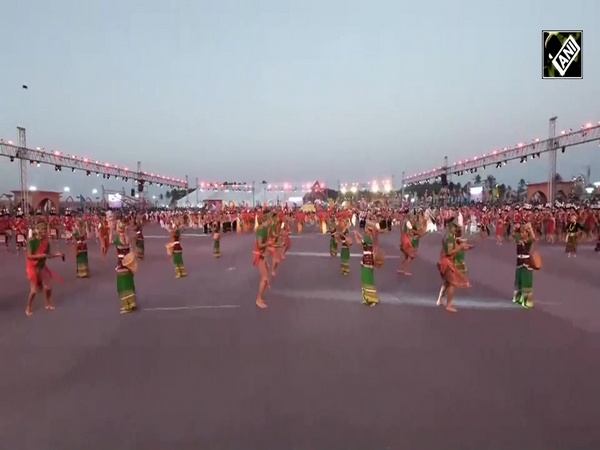What is China's grand strategy, and can it be attained?
Oct 20, 2020

Hong Kong, October 20 : Correctly or wrongly, Bonaparte Napoleon is often attributed as saying about China, "There lies a sleeping giant. Let him sleep, for when he wakes he will move the world." It is undeniable that China has risen economically, politically and militarily, becoming a strategic competitor with the world's preeminent superpower, the USA.
China has changed dramatically, that much is undeniable since Deng Xiaoping moved to open up a backwards and impoverished China to the outside world. More recently, under Chairman Xi Jinping, China has changed yet again. Xi's authoritarian leadership style has taken the country back to communism's ideological roots, demanding loyalty and punishing severely any who stand in his way.
China has had four successive grand strategies since the modern country was formed in 1949: revolution (1949-77), recovery (1978-89), building comprehensive national power (1990-2003) and rejuvenation (2004 to the present). Yet, even through these strategies, three core interests can be discerned, those of security, sovereignty and development.
"National rejuvenation" is the grand strategy of Xi, and every decision he makes is designed to advance China to glory via his "China Dream". Indeed, he wants a communist-controlled China that is well-governed, socially stable, economically prosperous, technologically advanced and militarily powerful by 2050. All these are covered by Xi's leitmotif of "socialism with Chinese characteristics for a new era".
Current Sino-US tensions are not just a phenomenon caused by President Donald Trump on the campaign trail, for resistance to Chinese influence has become a bipartisan modus operandi. The two countries' strategic rivalry is going to continue for many years.
Naturally, it is difficult to predict what China will look like in the next five years, let alone the next decade or the coming 30 years. However, some American researchers have attempted to do just that, predicting what China as a nation, and the Sino-US relationship, will look like in 2050.
A report with such predictions was recently published by the RAND Corporation. Entitled "China's Grand Strategy: Trends, Trajectories and Long-Term Competition", it was authored by seven RAND researchers. The report breaks down the strategic competition into the four key components of military affairs, diplomacy, economics, and science and technology.
The RAND report comes up with four scenarios for China in 2050, starting with the most positive and ending with the most negative. The first is a "triumphant China" where it realizes its grand strategy, and the second is an "ascendant China" where many but not all of its goals come to fruition. Moving down the scale, the third possible scenario is a "stagnant China" where these ambitions are left unfulfilled. The fourth and direst scenario is an "imploding China" where the very existence of the Chinese Communist Party (CCP) is seriously threatened.
Of course, many readers would like greater clarity than these broad scenarios, though it does come down to crystal ball gazing. There are so many complications and intangibles that can occur - such as the death of Xi, internal leadership struggles, more pandemics, military conflict over Taiwan or with the USA, a global recession, stricter imposition of social controls and so on.
Among such imponderables, the report's authors nevertheless offer this prediction: "By 2050, China most likely will have experienced some mixture of successes and failures, and the most plausible scenarios would be an ascendant China or a stagnant China. In the former scenario, China will be largely successful in achieving its long-term goals, while, in the latter scenario, China will confront major challenges and will be mostly unsuccessful in implementing its grand strategy."
China routinely talks about "win-win" outcomes, but it has become increasingly obvious to most that these are mere verbal niceties. Nobody "wins" more than China in generally one-sided exchanges, something that must be remembered in the context of China's grand strategy. Xi and the CCP think first, foremost and solely of preserving themselves as the ruling elite of China.
The fact is that the USA, and other neighbouring Asian countries, must anticipate increased risks from China. US military bases in South Korea and Japan, as well as allies like the Philippines, can expect restrictions on their ability to operate freely in the air and sea in the Western Pacific.
Incidentally, China promises it will never interfere with freedom of navigation in the South China Sea, and when it was building its reclaimed island bases there, it said they could be used as safe havens for fishermen, etc. This has never happened, belying such meaningless platitudes.
Something alarming happened on 15 October when civilian air traffic control in Hong Kong, which covers that flight information region, refused permission for a Taiwanese aircraft to fly to the Pratas Islands in the South China Sea. Hong Kong-based controllers told the regular civilian charter flight that "dangerous activities" were occurring and that the aircraft could not fly there. One controller said, presumably under orders from China, "The danger area is, eh, now on until further notice."
Such blatant interference has exacerbated fears that China will blockade or pressurize outlying Taiwanese islands. These charter flights are mainly used to move defense personnel (currently coastguard members) and supplies from Taiwan proper. Taipei defends the Pratas Islands only lightly, and the PLA has recently conducted military exercises around them.
The flight ban prompted Johnny Chiang, leader of Taiwan's opposition Kuomintang party, to ask on Facebook: "Does this mean that the communist's military has already begun joint blockade war operations in addition to regular exercises and intrusions?"
The military threat is growing as China throws its weight around and refuses to back down on new territorial claims. The report summarized: "...In recent years, Beijing has been more overtly ambitious and bolder in pursuing its grand strategy with greater attention to the global context, but the CCP-PLA [People's Liberation Army]-PRC elite's primary goals remain focused in the domestic arena, on China's periphery and in the Asia-Pacific. In other words, the regime's priorities continue to be largely regional. It is within the Asia-Pacific that Beijing looks to establish spheres of influence and create what amount to "no-go" areas where the military forces of other great powers - notably US armed forces - are unable to deploy or employ without exposing themselves to grave risk."
The chapter on military development is an interesting one, predicting that the PLA will prioritize resources on firstly "managing the relationship with and gaining a competitive advantage over China's chief competitor, the United States, and resolving threats emanating from that competition without derailing other strategic objectives (particularly those in the economic realm). The second is in gaining control over regional Asia-Pacific trends and developments, or controlling changes to the regional status quo in ways favourable to China, without exacerbating perceptions of a 'China threat' to regional security."
There is a domestic drag on the military caused by the CCP's paranoia about dissent at home, and this chews up attention and resources. Furthermore, the PLA must adapt to and master the massive restructuring introduced by Xi over the next decade or so.
The researchers added, "Perhaps most important will be the marriage of new and potentially disruptive technologies to military concepts. Historically, China's military scientists are active and productive when CCP leadership provides priority and resources. The priority and resources are available now and, barring a more severe economic downturn than expected, this likely will remain the case for at least the next 10-15 years." Thus, China is pursuing new technologies such as quantum computing/communications, artificial intelligence, hypersonics, new weapons (e.g. railguns) and biotechnology to steal a march on the USA.
The PLA's core missions include "ensuring the viability of China's strategic deterrent, moulding a joint force able to fight and win informalized limited wars, improving the PLA's counter-intervention capabilities and enhancing power projection capabilities". This explains why joint, missile, naval and strategic support forces are being favoured over the army. At the same time, China is improving space, cyber and information capabilities.
Ultimately, "The new structure...[will] strengthen CCP control of the military and will almost certainly make it easier for the civilian chairman of the CMC - Xi Jinping and his successors - to wield influence over the PRC's massive military establishment. Operationally, the restructuring should also improve jointness and enhance PLA power projection capabilities; and it likely will render by 2035 (if not before) a PLA that is more capable of increasing the risks and costs of US and allied contingency responses in the Indo-Pacific region. The PLA in this timeframe likely will be capable of contesting all domains of conflict - ground, air, sea, space, cyberspace and the electromagnetic environment."
These are solemn words, for China believes it is on an inexorable path upwards. China's leaders elucidate five- and ten-year plans because they confidently insist they and the CCP will be around for years to come. They foresee that the party will still be ruling China on its 100th anniversary in 2049.
Xi is in his strongman era, but he is best described as a "restructurer" rather than a "reformer". He is revamping Chinese institutions to bolster his own personal power and make the communist regime more resilient. Thus, he has been cleaning house domestically, getting rid of corrupt elements and competitors - though it remains to be seen whether Xi's circle is any "cleaner" than his predecessors - and then pursuing an offensive campaign internationally, whether claiming new territories for China in the South China Sea or along the Indian border or spreading Chinese influence through the ambitious Belt and Road Initiative.
In terms of relations with the USA, the RAND report lists three possibilities: The Sino-US trajectory could turn them into parallel partners (the most optimistic outcome), diverging directions or, the least hopeful, colliding competitors. The latter scenario "envisions a more competitive and contentious relationship. This trajectory is most likely to manifest in a triumphant China scenario in which Beijing becomes more confident and assertive. As the PLA is bolder and more energetic in seeking to expel US military forces from the Western Pacific (or elsewhere), the potential for confrontation and conflict increases."
China's leaders see the world as a series of four rings centred on their hallowed sanctuary in Beijing. The first ring covers China itself, and this is the most important and sensitive area because domestic instability is a constant threat. The second concentric ring is China's periphery - 14 adjacent countries and maritime areas. Indeed, China has fought wars with five of those neighbours since 1949.
The next ring outwards comprises the larger Asia-Pacific region, which China believes is its rightful sphere of influence where external powers should have only limited access if any at all. The final ring stretches the rest of the way around the globe, encompassing increasingly important areas such as the Middle East and Africa. Most alarming to the CCP's rulers is that the USA has the ability to influence and threaten China in each of these four concentric rings.
Three key questions exist that will help determine whether China is successful in its grand strategy. One is how deftly power is transferred to the following generations by the CCP, PLA and government. Leaders attempting to prolong their perch at the top could jeopardize smooth transitions, for instance.
A second question is whether these leaders can succeed in prolonging the CCP regime and sustaining the Chinese people's prosperity for the next 30 years. The final factor is whether China can raise its stature internationally - both economically and militarily, as well as playing a more prominent role in world affairs. Certainly, the manhandling of COVID-19 has severely punctured China's esteem in many nations' eyes.


















